Indexed In
- Open J Gate
- Genamics JournalSeek
- CiteFactor
- Cosmos IF
- Scimago
- Ulrich's Periodicals Directory
- Electronic Journals Library
- RefSeek
- Hamdard University
- EBSCO A-Z
- Directory of Abstract Indexing for Journals
- OCLC- WorldCat
- Proquest Summons
- Scholarsteer
- ROAD
- Virtual Library of Biology (vifabio)
- Publons
- Geneva Foundation for Medical Education and Research
- Google Scholar
Useful Links
Share This Page
Journal Flyer

Open Access Journals
- Agri and Aquaculture
- Biochemistry
- Bioinformatics & Systems Biology
- Business & Management
- Chemistry
- Clinical Sciences
- Engineering
- Food & Nutrition
- General Science
- Genetics & Molecular Biology
- Immunology & Microbiology
- Medical Sciences
- Neuroscience & Psychology
- Nursing & Health Care
- Pharmaceutical Sciences
Research Article - (2021) Volume 13, Issue 8
Assessment of Knowledge, Attitude and Practice of Institutional Delivery among Women of Reproductive Age in Gondar town, North West Ethiopia
Fikadu Nugusu Dessalegn*, Tilahun Ermeko Wanamo and Debebe WordofaReceived: 12-Aug-2021 Published: 06-Sep-2021, DOI: 10.35248/0974-8369.21.13.440
Abstract
Background: Institutional delivery is one way of decreasing maternal and neonatal mortality and morbidity, especially in developing countries. Despite a great public health effort, many women are still delivering at home by either TBA or relatives. In Ethiopia almost all birth takes place at home (85.5%) with only 14.5% of women delivered at health institutions.
Objectives: The main objective of this study was to assess the Knowledge, Attitude and Practice of women of reproductive age group in Gondar town.
Methods and Materials: The study was conducted in Gondar town, North west Ethiopia from April to June, 2017 by using descriptive community based cross sectional study design to assess knowledge, attitude and practice of women of reproductive age group in Gondar town, four sub cities(Kebele 08, 13, 15& 16) and three rural kebeles( azezo tekle haymanot, loza mariam and aba entonios) . The source population was all women of reproductive age (15-49yrs) in Gondar town, Kebele 08, 13, 15& 16 and the sample size was determined by using single population proportion by considering 95% level of confidence and 5% margin of error. Stratified random sampling technique was used to collect all study subjects.
Results: Out of 422 study subjects, most study participants (92.2%) heard about institutional delivery. 92% of study subjects had information regarding health institution delivery. Majorityv42.4%) of study subjects got information from health care provider. More than 85% of study subjects had information about problem of home delivery by either TBA or relatives. Out of the total, more than 85% of mothers believed that institutional delivery has benefit for mothers and the baby. From total of 98 study participants who experienced child birth for the last 12 months, more than 81.6% delivered at health institution.
Conclusion and recommendations: The result of this study indicates that all participants heard about institutional delivery. More than 85% of the participants had knowledge about attending delivery at health facility. Comparing to national figure (85.5%) of home delivery, the result of this study is better (10.2%). Majority of the participants had good attitude toward health institution delivery. According to our study it is better to make intense and consistent increased mass media regarding risk and potential problem related to home delivery. Further, it highly advised that all health facilities in Gondar town and its surrounding must provide regular and ongoing morning health education about institutional delivery for all clients visiting their institutions.
Keywords
Knowledge; Child birth; Morbidity
Introduction
Institutional delivery is one way of decreasing maternal and neonatal mortality and morbidity, especially in developing countries. Despite a great public health effort, many women are still delivering at home either by TBA or relatives [1].
According to report of united nation in 2015approximately 78% of all pregnant women received antenatal care (ANC) during pregnancy; only 66% were delivered at health institutions [2].
Maternal death in sub-Saharan African countries accounts for about half of world’s total death. The coverage of skilled obstetric care at delivery improved in all regions, but it has remained stagnant in African countries an average of 1 in 16 are still die in child birth in sub-Saharan African countries compared to 1 in350 in European countries [3].
The 2016 EDHS results show that 62% of women who gave birth in the five years preceding the survey received anti natal care from a skilled provider at least once for their last birth. In Ethiopia maternal mortality rate (MMR) is (412/100,000) and the infant mortality rate was 48 deaths per 1,000 live births. Child mortality rate was 20 deaths per 1,000 children surviving to age 12 months, while the overall less than 5 mortality rate was 67 deaths per 1,000 live births. The neonatal mortality rate was 29 deaths per 1,000 live births, and the post natal mortality rate was 19 deaths per 1,000 live births [4].
Literature review
Globally, it was estimated that 34% of Women delivered with no skilled attendants; this means there are 45 million births occurring at home without skilled health personnel each year. Skilled attendants in more than 99% of births in developed countries. In five countries including Ethiopia, the percentage drops to less than 20% [5].
More than 50% of all maternal death were only from six countries in 2008 (India, Nigeria, Pakistan, Afghanistan, Ethiopia and the Democratic Republic of Congo [6]. About 80% of maternal death are due to causes directly related to pregnancy and child birth [7] .Most sub- Saharan Africa countries are not on track for meeting the targets pertaining to MMR in MDGs [8].
As Ethiopian EDHS 2011 has shown, the MMR was 676 per 100,000 live births for the seven year period preceding the survey which is not significantly different from EDHS 2005 report (673 per 100,000 live births) [9].
The National Baseline Assessment for Emergency Obstetrics and Newborn Care in 2008 indicated that skilled delivery utilization was 7%. The majority of Ethiopian women give birth at home without skilled attendants [10].
Knowledge
It has been recognized that lack of formal education, low socioeconomic status has influence to institutional delivery. Several hospital based study aimed at assessing maternal mortality have been conducted in South Africa revealed that low proportion of ANC visit and inadequate knowledge of pregnant women to attend institutional delivery were the major factor for maternal mortality ratio to be 83 per 100,000 live birth. Exposure to mass media was one factor that limits the awareness of women to attend delivery at health institution [11].
Study conducted in Nepal, in Northern India showed that the percentage of delivery in health facilities was nearly double for women at higher educational level compared with uneducated women [12].
Another study conducted in Ghana found that women who had access to mass media or health information via Television were more likely to have institutional delivery than those were not in access to mass media [5].
In northern Sudan, 86% of births were delivered at home; only 12% of births were delivered in government hospital and only 1% of were taken place in private hospital, even in urban institutional birth accounts for only about 30% of delivery. These were due to inaccessibility to formal education and lack of awareness regarding institutional delivery [10]. Another study conducted in semiurban settlement of Zaria; in northern Nigeria showed that most women (70%) were deliver at home due to lack of awareness about attending delivery at health institution [13].
Majority of birth in Ethiopia were attended at home with urban and rural differential of 68.3% and 97.9% respectively, while only 5% of women were attend delivery in health institution, the proportion showed that major difference was among regions, the lowest(2.8%) in Amhara and the highest in capital city ,Addis Ababa (66.9%). This difference was due to accessibility to mass media and formal education in capital city, Addis Ababa [14].
Study conducted in Jimma town in 2009 on assessment of women on usage of institutional delivery, among 249 sampled mothers only 69.2% had good knowledge about service of institutional delivery [15].
Study conducted in Mekele revealed that most frequently reason for utilization of institutional delivery by women were better service given by health facility 206(51%) better outcome from institutional delivery 128(31.7%) and informed by health personnel to deliver in health institution were 34% [16].
Attitude
Study conducted in Bangladesh, the social stigma and distress of doctor’s recommendation for C/S were influence women not to attend delivery in health institution with skilled attendants [17].
In Ghana manager of health service looked at how midwives behavior affect pregnant women choice on place of delivery, 476women who participated in the study, only 17% were attend health institution delivery and the remaining 83% were delivered at home either by TBA or relatives due to neglected and abused by attitude of midwives, these was midwives shouted at them, in some cases, they threatened women in labor [18].
Another study conducted in Mozambique, among pregnant women, only 25% were seek for prenatal, delivery and postnatal medical care due to fear of social stigma and 75% were hidden their pregnancy at home [17].
The study conducted in Jimma university in 2007 on assessment of attitude being attended by health workers during pregnancy and delivery by total of 275 women who were pregnant and gave birth, 20(7.3%) of them agreed on importance of ANC and institutional delivery. Whereas 66 of them were disagree on its positive effect. 62% of those agreed said that easy to treat pregnancy related problem and 38% of these women said that mother get health education about need of nutrition during pregnancy [19].
Practice
Globally, the practice of institutional delivery and reduction of maternal mortality and morbidity are global priority, particularly in developing countries including Ethiopia where the maternal mortality ratio is one of the highest in the world. In Africa and Asia, only 46.7% and 58.3% of women gave birth with assistance of health personnel respectively. In less developed regions, the lowest level of skilled attendants at birth were ,eastern Africa (34.5%), central Asia (38.9%) and west Africa (40.9%) with highest level in south Africa (86.8%) [20].
In Ethiopia, institutional delivery at public and private hospital, health center and clinic were estimated to be only 14.5% for whole country [18]. A longitudinal community based study conducted in south west Ethiopia, only 16.7% of the women had delivered in health institution, while 34.1% of them from urban residents and only 1.9% were rural residents. The same study showed that 19.6% of deliveries were attended by health personnel with urban and rural differential of 39.8% and 24% respectively [21].
According to study conducted in Gulelle district, Addis Ababa, most pregnant women (55%) were preferred delivery in hospital,18.1% were preferred at health centre ,and while 24.3% of women preferred to attend delivery at home. Again 67% of women who preferred to deliver at home said that they wanted their delivery to be conducted by TBA, while 25% were preferred to be conducted by relatives or others. Similar study conducted in Addis Ababa showed that most frequent reason for preferring delivery in health institution was good and high quality service.50% of those respondents who preferred to deliver at home, 42.9% wished home delivery because of influence of relatives and 23.8% of them said that due to expense for delivery at health institutions were difficult to afford [22].
In Addis Ababa 84% of birth were attended by skilled providers, while 6% were in SNNP. According to EDHS-2011, 10% of birth in Ethiopia were delivered at health facility out of which 9% in public facility and 1% in private facility ,while 90% of births were delivered at home either by TBA or relatives. Based on residents, 50% of women in urban were delivered at health facility, while 4% of women in rural area were delivered in health facility. From these, 82% were delivered in health institution, in capital city Addis Ababa. On the other hand, less than 10% were delivered in health facility in regions of SNNP, Afar, Oromia, Somali and Benishangul. Out of 10% of birth assisted by skilled providers, 4% by Doctors, 7% by nurse or midwives, less than 1% by HEW and 57% of birth were assisted by relatives or some other persons. And 28% of births were assisted by TBA, while 4% of births were unattended. The proportions of birth were different from regions to Addis Ababa. Again concerning the reason not to deliver at health facility, 61% of women stated that delivery in health institution was not necessary, 30% respond that it was not customary and 14% said that the health facility was either too far or they do not have transportation [22] (Figure 1).
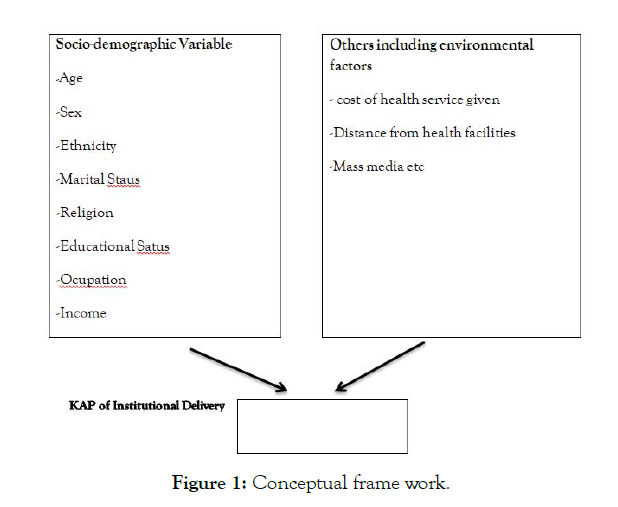
Figure 1: Conceptual frame work.
Materials and Methods
Study area and study period
The study was conducted at four urban kebeles and three rural kebeles in Gondar town. Gondar is located in Amhara National Regional state, which is far from about 750 km Northwest of Addis Ababa (the capital city of Ethiopia). It has area of 41.27 sq km with 2133-meter elevation. According to the 2007 population and housing census report, the total population size of Gondar town was estimated to be 206,987(98,085 males and the rest were females). Among these Amhara, Tigray and kimant are the most ethnic groups found. Majority of the population is followers of Christianity.
The town has 8 health center and 1 referral hospital serving the population of the town and outside. It consists of 12sub city 20 kebeles, 11rural kebeles and 1satelite kebele (I.e. tseda). Among these sub cities our study was conducted in four urban kebeles and three rural kebeles. The study was conducted from April to June, 2017
Study design
Quantitative descriptive community based cross-sectional study design was used to assess knowledge, attitude and practice of women of reproductive age toward institutional delivery in Gondar town at four urban kebeles and three rural kebeles.
Population
Source population: All women of reproductive age (15-49 years), who were residents in Gondar town.
Study population: All women of reproductive age (15-49 years) who was selected from source population & meet inclusion criteria.
Inclusion and Exclusion Criteria
Inclusion criteria: All women of reproductive age in the study area who were able to provide information was included in the study.
All women of reproductive age who were more than 6months in the study area was included in the study.
Exclusion Criteria:
All women of reproductive age who were unable tosee and hear.
All women of reproductive age who were severely ill during data collection.
All women of reproductive age who were infertile in respective HH.
All women of reproductive age with psychiatric problem during data collection period were not included in the study.
The sample size was determined by using single population proportion formula by considering the assumption of 95% level of confidence, 5% margin of error and taking the proportion as 50%.
Where: n=sample size
p= proportion is 50%
d= maximum allowable error (margin of error)
z= value of standard normal distribution (z-statistic) at 95% confidence level
This is 1.96
By adding 10% of non-response rate, the final sample size was =422.
Sampling technique
Stratified random sampling technique was used to select study units. from 20 urban kebeles, and 11 rural kebelesin Gondar town by using lottery method 4 urban kebeles(kebele ,08,13,15 and 16) and three rural kebelew( azezo, tekle haymanot, loza mariam and aba entonios) were selected. The sample was selected by using systematic random sampling technique. Equal allocation was used to collect the data as shown below Figure 2.
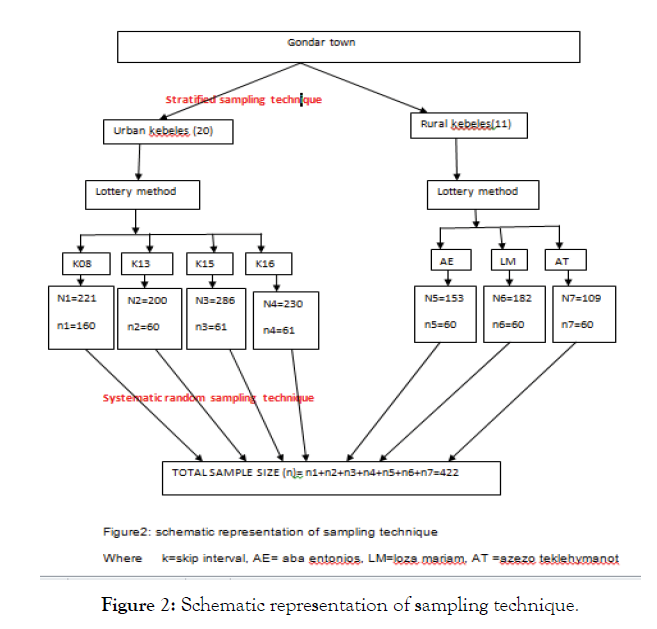
Figure 2: Schematic representation of sampling technique.
Sample size determination
Where k=skip interval, AE= aba entonios, LM=loza mariam, AT =azezo teklehymanot
N=total number of houses, N (1, 2, 3…) =number of houses in each kebele
n= total sample size n (1, 2, 3…) =sample size in each kebele
K08=N1 /n1=221/60=4 AT= N5/n5=153/60=3 Skip interval (k) at
K13=N2/n2=200/60=3 LM=N6/n6=182/60=3 each kebele
K15=N3/n3=286/61=5 AE=N7/n7=109/60=2
K16=N4/n4=230/61=4
Thus, the sample were taken at every value
Data collection method
The data was collected by 4th year midwifery students who were assigned to this particular topic using semi-structured questionnaires by moving from house to house through face to face interviewing of child bearing age Women in urban kebeles [23,8,9,10] and rural kebeles (azezo tekle haymanot, loza mariam and aba entonios) in Gondar town, until the desired sample size were achieved. The collected data was checked for completeness and finally, the data was collected from the students.
Study Variables
Dependent Variables:-
Knowledge of women on institutional delivery
Attitude of women toward institutional delivery
Practice of women at institutional delivery
Independent Variables
Socio-demographic variable;
Age
Sex
Ethnicity
Marital status
Religions
Educational status
Occupation
Income
Others including environmental factors;
Cost of service given
Distances from health facilities
Mass media etc.
Operational definition
Knowledge:-Information or awareness that Women had regarding institutional delivery
Good knowledge: The women who answer more than 85% of questions of knowledge about institutional delivery.
Attitude:-Way of perceiving of women toward institutional delivery (by using the five likert scale).
Positive attitude:-The women who were agreed more than 85% of importance of institutional delivery.
Practice: -Actual action of women giving birth at health institutions.
Institutional delivery: -Births that conducted by skilled health personnel in health facility.
Data collection tool and procedures
In this study, questionnaires were used in gathering relevant information. Data was collected using interview questionnaire. Questionnaires were developed and partly adapted from previous literatures and guideline.
Questionnaire: A semi-structured closed-ended interview Amharic version questionnaire was used for the study. By using interview questionnaire information about knowledge, attitude& practice of women of reproductive age was collected. The questionnaire was consists of respondent’s background information, knowledge, attitude and practice related questions.
Data quality control: Primarily the questionnaire was prepared in English and translated in to Amharic. It was then translate back into English by the principal investigators. The appropriate technique of data collection was used. The filled out questionnaires were checked for completeness on daily basis in the field by principal investigators.
Data processing and analysis: After checking its completeness and appropriateness, the collected data was entered in to EPI info version 3.5.3, export and analyzed using SPSS version 20.0, and then, the main findings of the study was interpreted in the form of appropriate figures like tables, percentage/ proportions, frequency and then, the results were compared and discussed with other already existing data such as literature reviews. Finally the findings of the study was concluded, recommended and disseminated.
| Variable | Categories | Frequency | Percentile |
|---|---|---|---|
| Occupational status | House wife | 214 | 50.70% |
| Governmental employee | 60 | 14.20% | |
| Private employee | 42 | 10% | |
| Merchant | 41 | 9.70% | |
| Other | 65 | 15.40% | |
| Total | 422 | 100% | |
| Can’t read & write | 94 | 22.30% | |
| Read & write only | 66 | 15.60% | |
| Educational status | Primary school(1-8) | 100 | 23.70% |
| Secondary school(9-12) | 100 | 23.70% | |
| College and above | 62 | 14.70% | |
| Total | 422 | 100% | |
| <500 | 58 | 13.70% | |
| 500-1000 | 179 | 42.40% | |
| Monthly income | 1001-1500 | 42 | 10% |
| 1501-2000 | 61 | 14.50% | |
| >2000 | 82 | 19.45% | |
| Total | 422 | 100% |
Table 1: Occupational status, educational status and monthly income of women in Gondar town, June 2017
Ethical Consideration: Ethical clearance was obtained from University of Gondar College of medicine & health science department of midwifery research review committee. Official letter was submitted to Gondar town kebele administrator to obtain their co-operation. Data collectors briefly explained the objective of the study& informed consent was obtained from study participants. Questioners also make to be anonymous to ensure confidentiality of the data. Participants were informed that they have the right to quit the study at any point of the research if they wish too. Furthermore, the study participants were reassured for an attainment of confidentiality for the information obtained from them. Participants were be informed not to write their name and complete the given questionnaires correctly.
Disseminations of the study: The findings of this study will be disseminated to university of Gondar, College of Medicine & Health Science, and Department of Midwifery and further, for Amhara. Regional Health Bureau, all health facility in Gondar town and its surrounding, and other concerned bodies.
Results
Socio-demographic characteristic
Concerning socio-demographic characteristics, out of total of 422 women of reproductive age with response rate of 100% included in the study, majority 104(24.6%) of them were ranged in the age between 25 and 29 Figure 3.
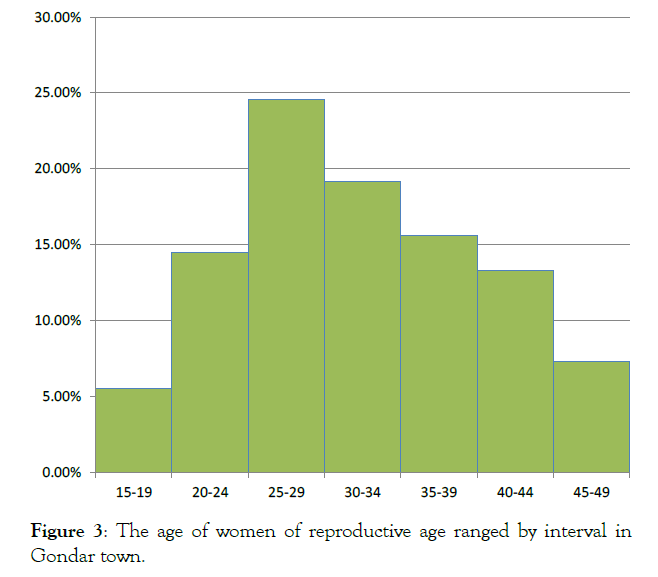
Figure 3: The age of women of reproductive age ranged by interval in Gondar town.
Concerning religious condition, from the total of 422 study subjects, majority of them 352 (83.4%) were Orthodox, and 60(14.2%) were Muslims, 8 (1.9% ) were protestant ,and the remaining(0.5%) were others (Jewish) Figure 4.
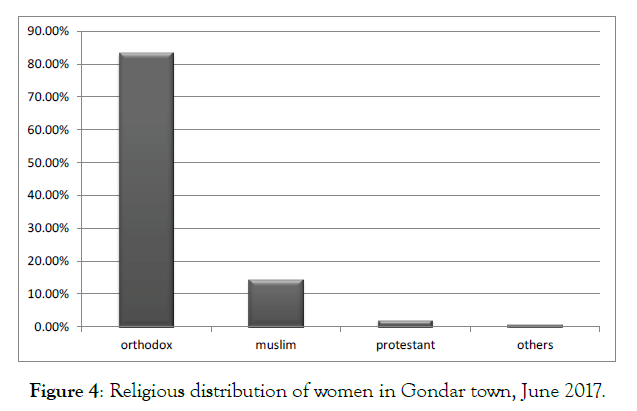
Figure 4: Religious distribution of women in Gondar town, June 2017.
From the total of 422 women participated in the study, 368 (87.2%) were Amhara, 31(7.3%) were Tigre, 21 (5.0%) were Kimant, 1(0.2%) were oromo and the remaining were others Figure 5.
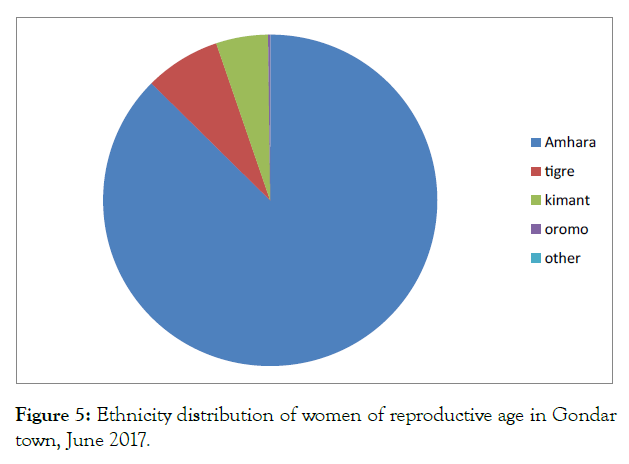
Figure 5: Ethnicity distribution of women of reproductive age in Gondar town, June 2017.
Regarding marital status, out of the total 422 respondents interviewed, majority of them, 281 (66.6%) were married, 80 (19.0%) were single 41 (9.7%) were divorced and the remaining 20(4.7%) were widowed. Figure 6.
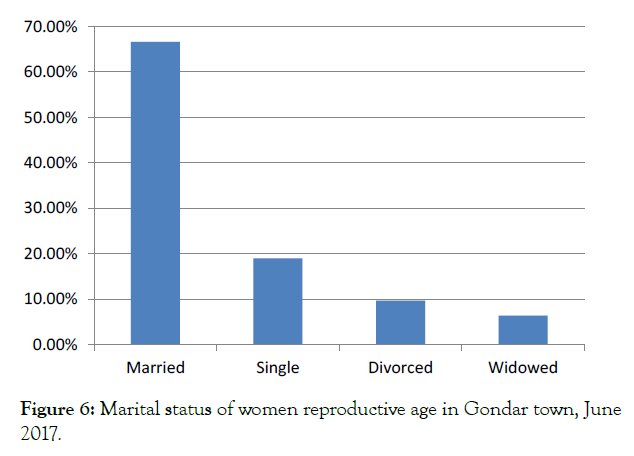
Figure 6: Marital status of women reproductive age in Gondar town, June 2017.
Concerning occupational status majority of reproductive age, women in Gondar town are housewife 214(50.7%). In contrast, the lowest are merchants 41(9.7%).
On educational status majority of them have learnt up to primary (1-8) 100(23.7%) and secondary school (9-12) 100 (23.7%) followed by the lowest have learnt college and above 62(14.7%). Concerning monthly income of reproductive age women in Gondar town 82(19.45%) have income of >2000ETBbut, 58(13.7%) have <500ETB.
Knowledge of women on institutional delivery
Concerning knowledge of women on institutional delivery, from the total of 422 respondents with response rate of 100%, most of them, 389(92.2%) was heard about institutional delivery. In other words, out of 422 mothers interviewed about delivery service of health institution, majority of them, 369 (87.4%) said that health institutions give delivery service for laboring mothers. While, 20(4.7%) of them respond that health facility does not give delivery and the remaining 33(7.8%) had not knowledge about delivery service of health institution (Figure 7).
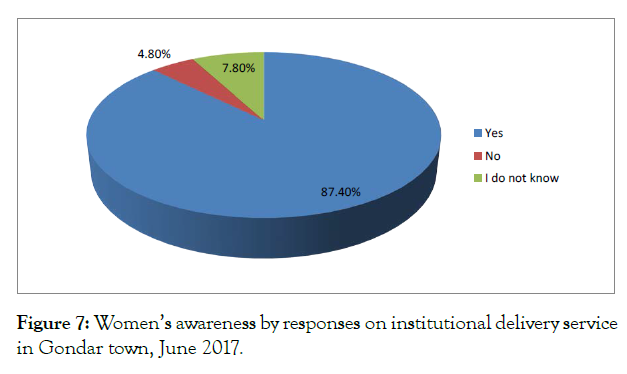
Figure 7: Women’s awareness by responses on institutional delivery service in Gondar town, June 2017.
From the total of, 422 respondents, 374 (88.6%) had information on attending delivery in health institution than home delivery is advantageous. While 12(2.8%) of them had no and the remaining 36(8.5%) had no idea. Again from the total of women that had informed about importance of institutional delivery, majority of them,179(42.4%) were get information from health care provider,102(24.2) from both mass media and health care persone l,76(18%) from mass media and the remaining 13(3.1%), & 5(1.2%) were get from other source (self-knowledge friends& TTBA) (Figure 8).
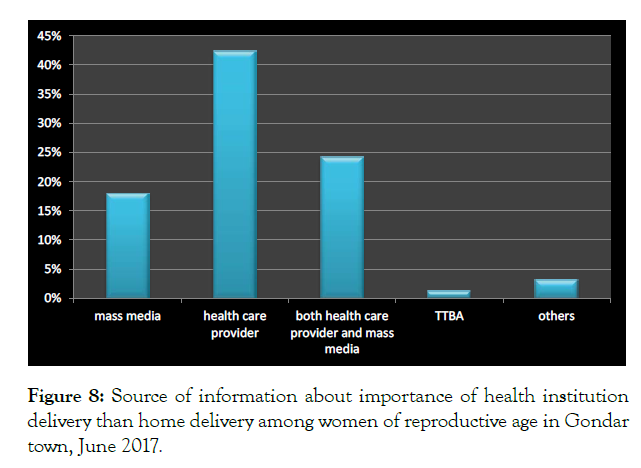
Figure 8: Source of information about importance of health institution delivery than home delivery among women of reproductive age in Gondar town, June 2017.
Regarding the knowledge of mother on benefit of attending delivery in health facility, out of 422 mothers interviewed, majority of them 376(89.1%) had information about significance of attending delivery in health institution. But the remaining 46(10.9%) had no. From the total of 376(89.1%) mothers that had knowledge on attending delivery in health institution, majority 135(27.83%) of their responses were on minimize of maternal and newborn complication during labor and delivery (Table 2).
| Variable | Categories | Frequeny | Percentile |
|---|---|---|---|
| Awareness of mother by response | Early detection of problems and referral | 73 | 17.3 |
| Minimize blood loss during delivery and post-partum | 234 | 55.5 | |
| Minimize risk factors for puerperal sepsis | 73 | 17.3 | |
| Minimize delivery related complication of both baby and mother | 152 | 36 | |
| Other | 7 | 1.7 |
Table 2: Awareness of women of reproductive age by response on specific methods practiced by health facilities in Gondar town, June 2017.
Out of the total of 422 women interviewed regarding problem of home delivery by TBA or relatives, majority 359(85.1%) of the respondents said that home delivery by TBA or relatives has a problem to the mother and her baby. But 52(12.3%) of them reported that no problem with home delivery. And the remaining 11(2.6%) were responded that they did not know the problem related to home delivery.
In general, 82% of reproductive age women in Gondar town are knowledgeable about institutional delivery, while the remaining (18%) of them needs further education on institutional delivery.
Attitude of women toward institutional delivery
Concerning attitude of women toward institutional delivery, of total numbers of study subjects, 379 women, more than 89% were believed that attending delivery in health institution can decrease maternal and child mortality rate. But 18(4.3%) of them were not, of them 5(1.2) said that maternal and child death is decided by GOD while others 13(3.1) said that attending delivery in health institution has no effect on maternal and child mortality. And the remaining 25 (5.9%) of them had no idea (Figure 9 and Table 5).
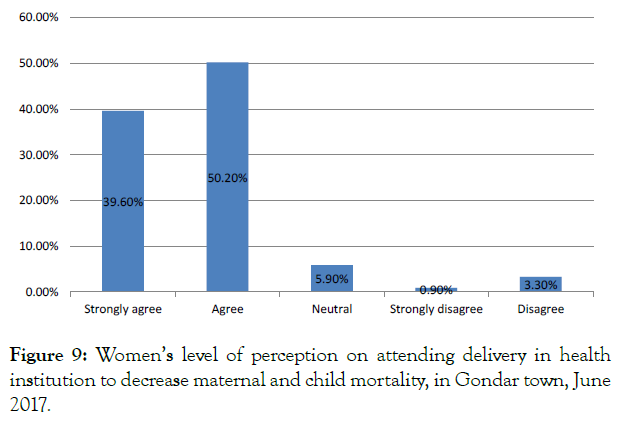
Figure 9: Women’s level of perception on attending delivery in health institution to decrease maternal and child mortality, in Gondar town, June 2017.
Among the total participants that interviewed, 390 (92.5%) agreed that attending delivery in catchment health unit has positive benefit for both mother and baby. On the other hand, 10(2.4%) did not agree and the remaining 22 (5.2%) were report that they had no idea (Figure 10).
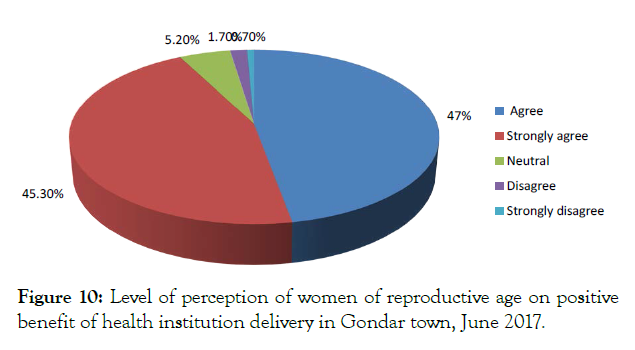
Figure 10: Level of perception of women of reproductive age on positive benefit of health institution delivery in Gondar town, June 2017.
Concerning payment by the mothers for health institution at the time of delivery, from 422 mothers interviewed, majority 360(85.3%) of them were reported that no payment for pregnant women who attend delivery in health institution. But the remaining 62(14.7%) of the participants said that pregnant women pay fee for delivery service in health institution (Table 4).
In general, more than 89% of women in Gondar town have positive attitude towards institutional delivery, but the remaining have no positive attitude towards institutional delivery.
Practice of women on delivering at health facilities
Table 5 Among total number of 422 women interviewed on experienced childbirth for the last 12 month, 98(23.2%) of them had experienced child births and the remaining 324(76.8%) of them were not (Table 6).
| variable | Categories | Frequency | Percentile |
|---|---|---|---|
| by prevention of infection using aseptic techniques | 84 | 19.9 | |
| by minimization of blood loss during delivery &post-partum | 233 | 55.2 | |
| by early detection of complication and referral | 135 | 32 | |
| all service are given in health institution | 177 | 41.9 | |
| Other | 6 | 1.4 |
Table 3: Perception of women of reproductive age on specific methods practiced by health institution to decrease maternal and child mortality in Gondar town, June 2017.
| Variable | response | frequency | Percent |
|---|---|---|---|
| Perception | yes | 62 | 14.7 |
| No | 360 | 85.3 | |
| Total | 422 | 100 |
Table 4: Perception of women of reproductive age on payment for health institution at the time of delivery, in Gondar town, June 2017.
| Variable | categories | frequency | Percent |
|---|---|---|---|
| Number of children | none | 86 | 20.4 |
| one | 66 | 15.6 | |
| three | 64 | 15.2 | |
| four | 45 | 10.7 | |
| >four | 78 | 18.5 | |
| Total1 | 422 | 100 |
Table 5: Number of children of women reproductive age in Gondar town, June 2017
| Variable | Categories | Frequency | Percent |
|---|---|---|---|
| Women | Experienced child birth in the last 12 months | 98 | 23.2 |
| Not experienced child birth in the last 12 months | 324 | 76.8 | |
| Total | 422 | 100 |
Table 6: Number of women experienced and not experienced childbirth in the last 12 months in Gondar town, June 2017.
From the total of 98 women who experienced child birth in the last 12 months, majority 80(81.6%) of them were delivered in health institution, the 10(10.2%) were gave birth at their home & the remaining 8(8.2%) were gave birth on the way to health facilities (Figure 11).
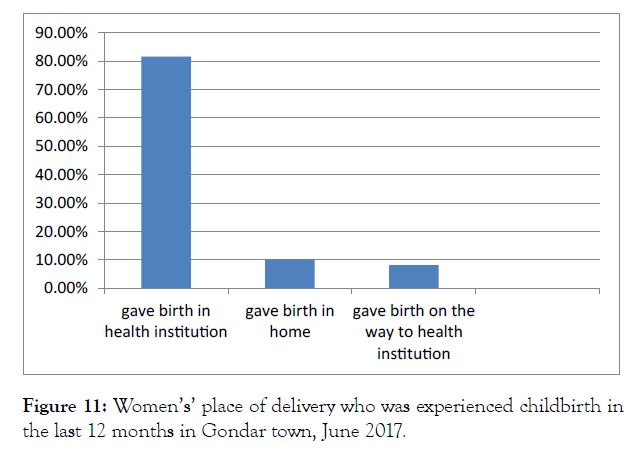
Figure 11: Women’s’ place of delivery who was experienced childbirth in the last 12 months in Gondar town, June 2017.
Concerning reason for home delivery, out of 10(10.2%) respondents delivered at home in the last 12months, 4(40.0%) of them were reported that gave birth at home was due to lack of awareness, 3(30.0%) was due to their preference, and the remaining 3(30.0%) were others (financial and transport problem, labor started accidentally) (Figure 12).
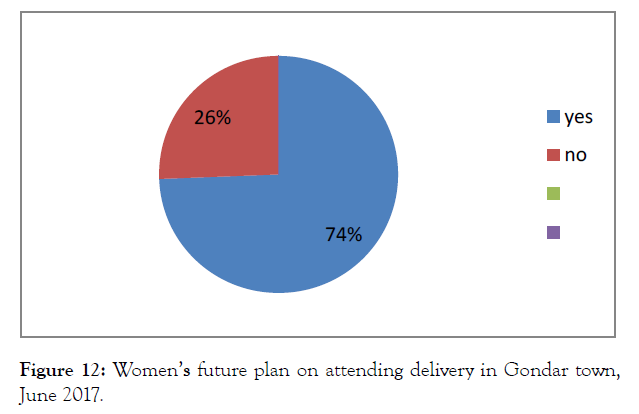
Figure 12: Women’s future plan on attending delivery in Gondar town, June 2017.
Out of total 422 study subjects interviewed on plan regarding institutional delivery, majority 314(74.4%) of them were report that they had plan to attend their next delivery at health facility. While the remaining 108 (25.6%) had no plan. Among those participants who had no plan to attend health institution for the next delivery, more than 85% of them said that the reason not to have plan to attend their delivery in facility was due to they reach desire number of children, 10(9.3%) were due to fear of financial and transport problem and the remaining 3(2.8%), 2(1.8%),1(0.9%) of them were report that it was due fear of religion & culture, fear of family& others(lack of privacy) respectively.
Discussion
Knowledge of women on institutional delivery
A majority (87.4%) of study participants said that they knew delivery service given by health facility. This was a higher percentage than 51% in Mekelle [16]. This might be due to increased mass media and health education about institution delivery.
From the total of 422 study participants, majority (88.6%) of them had good knowledge regarding institutional delivery than home delivery. This finding was higher than findings from Jimma town which was 69.2% [24]. This may be due to increased mass media and morning health education program in health facility about attending delivery at health institution.
From the total of 422 study subjects, majority (42.4%) of them were get information from health care personnel and only 18% were informed from mass media. When it compared with the findings study conducted in Mekelle regarding information from health workers which was 34% [16]. This was lower and this discrepancy might be due to social stigma and cultural attitude of the society toward health care providers.
Out of the total of 422 women interviewed regarding problem of home delivery by TBA or relatives, majority (85.1%) of respondents said that home delivery has relative effect on health of mothers and the baby. This was higher than that of capital Addis Ababa which was 66.9% [9]. This might be due to expansion of health extension program, increased morning health education program at health facility and increased mass media about institutional delivery.
Attitude of women toward institutional delivery
Out of the total 422 study subjects, more than 89% were believed that attending delivery in facility can decrease maternal and child mortality rate. This finding was slightly higher than the findings of study conducted in Ghana which was 83% [6].But it was higher than 75% of study conducted in Mozambique [10]. Among the total participants that interviewed, more than 92% were agreed that attending delivery in catchment health unit has positive benefit for both mother and the baby. When we compare this with similar study conducted in Jimma University which was 7.3% [11], it was much higher. This might be due to increased mass media about institutional delivery, ANC utilization and expansion of health facilities and government consideration on maternal and child health, so that health extension program was expanded.
Practice of women on attending delivery in health institution
From the total 98 (23.2%) of study subjects who were experienced child birth for the last 12 months of preceding the study, majority (81.6%) were attend delivery in health facility where the remaining 10.2% were delivered at home& 8.2% were delivered on the way to health facility. When we compare these findings with findings of EDHS-2011, Addis Ababa which was 82 % [14], it was almost the same in percentage. But, comparing with the total national figure of institutional delivery of EDHS-2014, which was 14.5% of whole country [15], the result of this study was much higher than that the national figure. This might be due to collaboration of health extension workers with respective health facility and increased mass media about institutional delivery.
Concerning reason for home delivery, out of total 10 (10.2%) respondents who delivered at home in the last 12 months preceding the study, 4(40%) were due to lack of awareness. When we compare with the findings of study conducted in Gulelle district, Addis Ababa, home delivery in which home delivery was 25% (20), the result of this study was higher in magnitude. The other reason for home delivery was due to their preference of home delivery by relatives (30%) and the remaining (30%) was due to other causes (culture & religion influence, financial & transport problem). When compared with the findings of study conducted in Addis Ababa, preferring of home delivery were due to their preference (24.3%) [13]. These was lower than the result of this study in magnitude.
Conclusion
The findings of this research revealed that most participants (92.2%) were heard about institutional delivery. Despite having information of attending health institution delivery, still more than 10% of the women are attending their childbirth at home. These indicate the need for increasing clients’ knowledge on attending delivery in health facility. According to this study results, more than 85% of the participants had knowledge regarding problem of home delivery by either TBA or relatives. Even though the majority reported a good attitude toward institutional delivery one-tenth of them were still practiced home delivery. However, comparing to national (85.5%) of home delivery, the results of this study was much better, which was 10.2% of the mothers attending delivery at home. Out of the total 422 interviewed on plan of attending institutional delivery, majority of them (74.4%) had planned to attend their subsequent delivery at health facility. In general, the knowledge about institutional delivery, the attitude toward attending delivery at health facility, the majority of the respondents was encouraging.
Recommendation
Based on the findings of this study, it is better to make intense and consistent mass media regarding risk and potential problem related to home delivery. On the other hand, there should be availability of free service regarding institutional delivery in all government health sectors. In addition to this, health education with focused and culturally sensitive information, education, communication and behavioral change should be provided in mass media, in all health facilities and at community gathering (for FMOH).
Further, it is better that amhara regional health bureau launch an intensive and continuing education campaign to increase the knowledge of pregnant women and their partners about health institution delivery and problem of home delivery by either TBA or relatives.
Lastly, it is highly advised that all health facilities in Gondar town and its surrounding must provide regular and ongoing health education, sessions for all ANC attendants and those in postnatal after delivery, and even those who visit hospital for family planning or another services.
REFERENCES
- Shegaw MT, Leslie Sue L, Vincentas G. EDHS, Ethiopian Demographic Health Survey. 2014.
- WHO, World Health Organization, World population data sheet. 2006.
- Bekele T, Rasschaert F, Assefa Y, Berhe A. FMOH, Federal Ministry of Health, Maternal health. 2006; 89-91.
- Erkihun TA, Temesgen YA, Kassahun AG.Spatial distribution and determinants of acute respiratory infection among under-five children in Ethiopia. Ethiopian Demographic Health Survey. 2016.
- WHO, world health organization fact sheet maternal mortality, Geneva. 2001; 16(4): 42-76.
- Halisçelik E, Soytas MA Sustainable development from millennium 2015 to Sustainable Development Goals. 2030. 2015.
- WHO/UNICEF, revised, estimated maternal mortality a new approach by WHO. 1996.
- USAID Population Reference Bureau: Making pregnancy and child birth safer, Police brief. USA.
- Tariku D, Eshetu G. Central Statistical Agency. ICF International: Ethiopian Demographic and Health Survey.
- FMOH, UNICEF, UNFPA, WHO and AMDD National Baseline Assessment for Emergency Obstetrics and Newborn Care in Ethiopia 2008: 18. Addis Ababa, Ethiopia, Calverton, Maryland. USA Google Scholar 2012.
- Nigussie H, Mitike G, Mariam DH. Assessment of safe delivery safe service utilization among child bearing age in northern Gondar. 2004; 72:58.
- Kesterton AJ Cleland, A. Sloggett, C. Ronsman. Institutional delivery in rural India: the relative importance of accessibility I the economic status. BMC pregnancy and child birth. 2010;10(30):1-20.
- Prota N, Passion P, Rowan B, Walsh G. Attendant journal of few birth in rural area of Nigeria. 2004: 17(25): 41-43.
- Federal democratic of Ethiopia, ministry of health. Health and health related indicator Health institutions. 2011: 29(2): 81-91.
- Haile Miriam A, Tselish M, Nicolas S. Knowledge and partner use of maternal and child care on improving and expansion of family planning service: NGO and private sector in Ethiopia. J. Fam. Health. 2002; 70(73): 38-43.
- CSA (Ethiopia) and ICF Intel. Ethiopia demographic health survey 2011. Addis Ababa Ethiopia and Calverton, Maryland USA: CSA and ICF Intel. 2012.
- KetrahAmparasah N, Sageo Moses EI. Expectant mother and the demand for institutional delivery. Do house hold income and access to health information matter. Some site from developing countries, European journal social science2009; 8(3): 469.
- Sumatran K, Vinod MI, Rutherford D. Promoting institutional delivery in rural Ghana, the role of ANC service. National family health survey sub- report, December. 2004; 20(1): 12-14.
- Ministry of health and World health organization on assessment of reproductive health in Ethiopia 2011; 13-22.
- Paul and Ramsey. Maternal health and level of knowledge. 2009;20(1):12-14.
- Mesfin N, Damen HM, Getnet M. Assessment of safe delivery service utilization among women child bearing age in south west Ethiopia. Ethiop J Health Dev. 2004; 18(3):146-152.
- World health report 2008 makes every mother count EDHS. 2011; 5-11.21:p(2):127-130.
- Central statistics agency (Ethiopia) and ORC macro Ethiopian demographic and health survey 2005. Addis Ababa Ethiopia and Calverton, Maryland USA. 2006.
- WHO Maternal Mortality in 2005. Estimates Developed by WHO, UNICEF and UNFPA, Geneva. 2007.
- UNICEF .Progress on MM, Geneva. 1996.
Citation: Dessalegn FN, Wanamo TE, Wordofa D (2018) Assessment of Knowledge, Attitude and Practice of Institutional Delivery among Women of Reproductive Age in Gondar town, North West Ethiopia . Bio Med 13: 440.
Copyright: © 2021 Dessalegn FN, et al. This is an open access article distributed under the terms of the Creative Commons Attribution License, which permits unrestricted use, distribution, and reproduction in any medium, provided the original work is properly cited.


